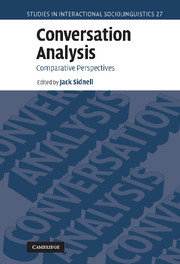Book contents
- Frontmatter
- Contents
- List of figures
- List of tables
- List of contributors
- Transcription conventions
- Part I Introduction
- Part II Repair and beyond
- 2 Repetition in the initiation of repair
- 3 A cross-linguistic investigation of the site of initiation in same-turn self-repair
- 4 Repairing reference
- Part III Aspects of response
- Part IV Action formation and sequencing
- Part V Conclusion
- Bibliography
- Index
4 - Repairing reference
Published online by Cambridge University Press: 15 December 2009
- Frontmatter
- Contents
- List of figures
- List of tables
- List of contributors
- Transcription conventions
- Part I Introduction
- Part II Repair and beyond
- 2 Repetition in the initiation of repair
- 3 A cross-linguistic investigation of the site of initiation in same-turn self-repair
- 4 Repairing reference
- Part III Aspects of response
- Part IV Action formation and sequencing
- Part V Conclusion
- Bibliography
- Index
Summary
Introduction
Languages provide speakers with resources for both referencing and repairing. While referencing is crucial for sustaining intersubjectivity, repairing is crucial for re-establishing intersubjectivity (Auer 1984; Schegloff 1992a; Schegloff et al. 1977). This chapter describes a repair-initiation action that claims that a particular aspect of the prior turn presents “trouble” for its speaker (e.g., understanding the prior turn; for a review of “repair” and its associated terminology, see Schegloff 1992a). The trouble source is treated as being a pro-term/indexical expression (e.g., “it”, “this”, “that”). The repair operation – that is, the interactional move that is performed by the speaker of the trouble source in response to the repair-initiation action being investigated, and that is designed to deal with/resolve the trouble – involves producing a full-reference form/full noun phrase (NP) (e.g., “the folder”, “the token”, “the ticket”) that is relevantly associated with the trouble-source indexical expression. Given that the trouble-source speaker orients to the trouble source as being an indexical expression, and given that the trouble-source speaker resolves the trouble by producing a recipient-designed full-reference form, the repair-related trouble can be characterized as a referent that is (claimed to be) underspecified for the person initiating repair. Languages provide for different types of referents, such as people, places, times, and things. This chapter focuses on a comparative analysis of one repair-initiation action in English and German that always (in our data) is taken by trouble-source speakers as targeting underspecified “thing”-referents. The repair-initiation action being examined is implemented by “Was denn” or “Was.”
Information
- Type
- Chapter
- Information
- Conversation AnalysisComparative Perspectives, pp. 104 - 132Publisher: Cambridge University PressPrint publication year: 2009
Accessibility standard: Unknown
Why this information is here
This section outlines the accessibility features of this content - including support for screen readers, full keyboard navigation and high-contrast display options. This may not be relevant for you.Accessibility Information
- 37
- Cited by
